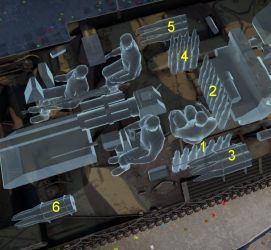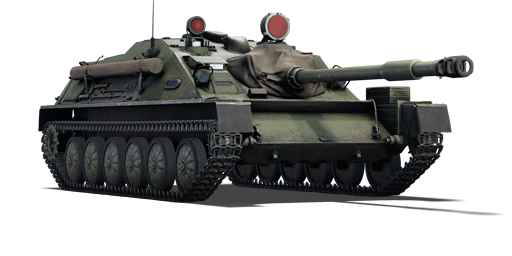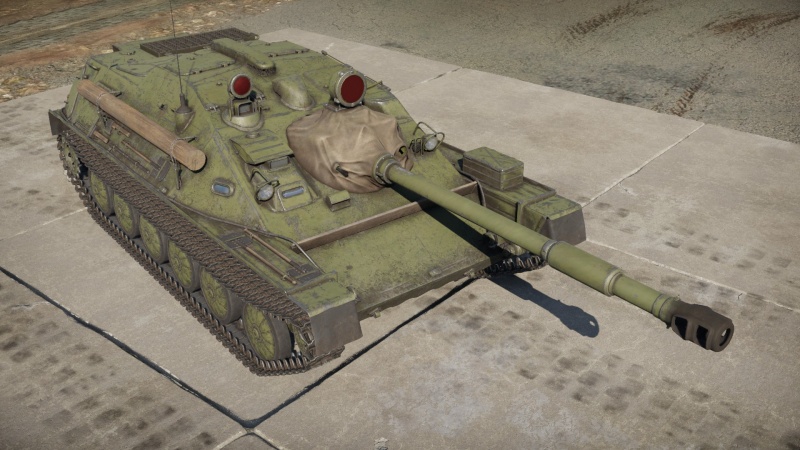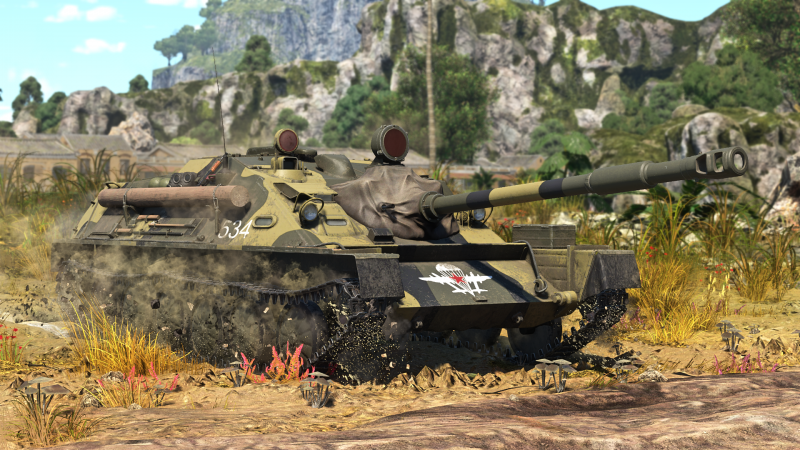Difference between revisions of "ASU-85"
(New Description Project - USSR Priority - ASU-85) (Tag: Visual edit) |
(→Description) |
||
| Line 6: | Line 6: | ||
== Description == | == Description == | ||
<!-- ''In the description, the first part should be about the history of the creation and combat usage of the vehicle, as well as its key features. In the second part, tell the reader about the ground vehicle in the game. Insert a screenshot of the vehicle, so that if the novice player does not remember the vehicle by name, he will immediately understand what kind of vehicle the article is talking about.'' --> | <!-- ''In the description, the first part should be about the history of the creation and combat usage of the vehicle, as well as its key features. In the second part, tell the reader about the ground vehicle in the game. Insert a screenshot of the vehicle, so that if the novice player does not remember the vehicle by name, he will immediately understand what kind of vehicle the article is talking about.'' --> | ||
| − | The '''ASU-85 (Авиадесантная самоходная установка, АСУ-85)''' | + | The '''ASU-85 (Авиадесантная самоходная установка, АСУ-85)''' was a Cold War-era Soviet-designed airborne self-propelled gun. It began to replace the open-topped [[ASU-57]] in service in 1959. Beginning in 1969, it was superseded by the BMD-1. It was designed to replace older designs such as the ASU-57 for use by the Vozdushno-Desantnye Voyska (VDV). Its design was lengthy and intricate, and it took nearly ten years to complete due to the demanding demands of getting the vehicle airborne. The ASU-85 saw duty as late as the Soviet-Afghan War, but it was far from widespread. The ASU-85 was based on the [[PT-76 (Family)|PT-76 light amphibious tank family]] chassis, however, it lacked amphibious characteristics and was powered by a different engine. The vehicle was divided into three compartments: the driver's compartment at the front, the combat compartment in the centre, and the engine compartment in the back. The ASU-85 was utilized in airborne missions by the Soviet Airborne Forces. With minimal anti-tank capability, its primary function was light infantry support or assault fortifications. The ASU-85 was only exported to two other Warsaw Pact countries: East Germany and Poland. NATO first noticed it in 1962, and it was frequently utilized by Soviet and Polish airborne units. |
| − | Introduced in [[Update 1.59 "Flaming Arrows"]], the ASU-85 is a unique vehicle that survives on the battlefield through stealth. It is particularly vulnerable if caught in the open due to the very | + | Introduced in [[Update 1.59 "Flaming Arrows"]], the ASU-85 is a unique vehicle that survives on the battlefield through stealth. It is particularly vulnerable if caught in the open due to the very thin roof armour, especially against planes. The armament can deal with almost any tank that the ASU-85 is likely to encounter. Unfortunately, the ASU-85 lacks the mobility of its forefather, the ASU-57, and must play more passively. On city maps, where engagements are typically close-range, this could be a problem. Overall, the ASU-85 is a situational vehicle that excels on large maps and circumstances where the terrain allows for stealth ambush but struggles in close-quarters combat. |
== General info == | == General info == | ||
Revision as of 09:25, 8 October 2023
Contents
Description
The ASU-85 (Авиадесантная самоходная установка, АСУ-85) was a Cold War-era Soviet-designed airborne self-propelled gun. It began to replace the open-topped ASU-57 in service in 1959. Beginning in 1969, it was superseded by the BMD-1. It was designed to replace older designs such as the ASU-57 for use by the Vozdushno-Desantnye Voyska (VDV). Its design was lengthy and intricate, and it took nearly ten years to complete due to the demanding demands of getting the vehicle airborne. The ASU-85 saw duty as late as the Soviet-Afghan War, but it was far from widespread. The ASU-85 was based on the PT-76 light amphibious tank family chassis, however, it lacked amphibious characteristics and was powered by a different engine. The vehicle was divided into three compartments: the driver's compartment at the front, the combat compartment in the centre, and the engine compartment in the back. The ASU-85 was utilized in airborne missions by the Soviet Airborne Forces. With minimal anti-tank capability, its primary function was light infantry support or assault fortifications. The ASU-85 was only exported to two other Warsaw Pact countries: East Germany and Poland. NATO first noticed it in 1962, and it was frequently utilized by Soviet and Polish airborne units.
Introduced in Update 1.59 "Flaming Arrows", the ASU-85 is a unique vehicle that survives on the battlefield through stealth. It is particularly vulnerable if caught in the open due to the very thin roof armour, especially against planes. The armament can deal with almost any tank that the ASU-85 is likely to encounter. Unfortunately, the ASU-85 lacks the mobility of its forefather, the ASU-57, and must play more passively. On city maps, where engagements are typically close-range, this could be a problem. Overall, the ASU-85 is a situational vehicle that excels on large maps and circumstances where the terrain allows for stealth ambush but struggles in close-quarters combat.
General info
Survivability and armour
The front upper glacis plate, while only 45 mm thick, is quite heavily sloped and can occasionally ricochet rounds. The mantlet is also quite thick and rounded, and it can also bounce the occasional lucky shot.
However, the rest of the ASU-85 is very thinly armoured and vulnerable to even heavy machine guns. Angling is useless in this tank, since thin armour parts get overmatched by high calibre shells and they just ignore ricochet chance completely. If it is necessary to give the enemy something to fire at, it is possible to take only half of the shells and then present the left side to the enemy, as it will have less ammo racks, though it is still likely the entire tank will be obliterated anyway.
The tank itself is very short and can even bully tanks like the M4A3 (76) W by standing next to them, as it will only be able to aim at the autobounce zone on top of the ASU-85 and will likely miss. In the case if the tank it stands next to explodes, the ASU-85 will also suffer overpressure damage and often lose crew, so moderate levels of "vitality" crew skill are needed to survive when doing this.
The ASU-85 is also somewhat vulnerable to aircraft strafing, particularly if they attack from the top or with rockets.
Armour type:
- Rolled homogeneous armour
- Cast homogeneous armour (Gun mantlet)
| Armour | Front | Sides | Rear | Roof |
|---|---|---|---|---|
| Hull | 45 mm (60°) Front glacis 45 mm (37°) Lower glacis 50 mm Driver port |
6 mm | 6 mm (40°) Upper 6 mm (18°) Lower |
6 mm |
| Superstructure | 45 mm (60°) Front glacis 100 mm Gun mantlet |
13 mm (37-38°) | 6 mm | 13 mm Front 6 mm Rear |
Notes:
- Suspension wheels are 10 mm thick, tracks are 15 mm thick.
Mobility
| Game Mode | Max Speed (km/h) | Weight (tons) | Engine power (horsepower) | Power-to-weight ratio (hp/ton) | |||
|---|---|---|---|---|---|---|---|
| Forward | Reverse | Stock | Upgraded | Stock | Upgraded | ||
| Arcade | 49 | 6 | 15.9 | 298 | 401 | 18.74 | 25.22 |
| Realistic | 45 | 6 | 186 | 210 | 11.7 | 13.21 | |
The ASU-85 is based on the PT-76B and uses the same engine. It is somewhat heavier, however, and the mobility thus suffers comparatively. With a top speed of under 50 km/h, the ASU-85 is relatively slow for such a lightly armoured vehicle, but it is adequate enough for repositioning when needed. The ASU-85 also has a fairly slow reverse speed and only one reverse gear, inherited from the PT-76B.
Note that the ASU-85 is not amphibious, unlike the PT-76B it is based on.
Modifications and economy
Armaments
Main armament
The ASU-85 is armed with the 85 mm D-70, a significantly more powerful gun compared to the wartime Soviet 85 mm ZiS S-53 and D-5T guns and comparable in capability to the German 8,8 cm L/71 guns. The mounting has only 4° of gun depression due to the restricted size of the vehicle, but has a fairly generous amount of traverse for a casemate tank destroyer. It has a relatively low rate-of-fire for its calibre, reflecting the rather cramped crew compartment of the ASU-85. The recoil of a gun throws the tank around, especially if it is fired sideways, sometimes kicking the tank backwards up to 5-10 m.
The standard shell is the BR-372 APBC shell with a lethal explosive filler. It has an excellent muzzle velocity and is accurate at long ranges, very similarly to APDS. It will also easily penetrate most things that the ASU-85 may encounter. Anything that cannot be penetrated by the APBC shell will almost certainly be penetrable by the 3BK7 HEAT-FS round. Boasting 300 mm of penetration, it is capable of punching straight through a Tiger II's upper glacis and does not lose penetration over distance. However, it suffers the usual drawbacks of HEAT rounds (cannot go through obstacles like trees or fences) and is significantly less lethal than the APBC shell. The muzzle velocity is also lower, which can complicate aiming at long ranges.
| 85 mm D-70 | Turret rotation speed (°/s) | Reloading rate (seconds) | |||||||||||
|---|---|---|---|---|---|---|---|---|---|---|---|---|---|
| Mode | Capacity | Vertical | Horizontal | Stabilizer | Stock | Upgraded | Full | Expert | Aced | Stock | Full | Expert | Aced |
| Arcade | 39 | -4°/+15° | ±15° | N/A | 6.2 | 8.5 | 10.4 | 11.5 | 12.2 | 9.23 | 8.17 | 7.53 | 7.10 |
| Realistic | 4.2 | 4.9 | 6.0 | 6.6 | 7.0 | ||||||||
Ammunition
| Penetration statistics | |||||||
|---|---|---|---|---|---|---|---|
| Ammunition | Type of warhead |
Penetration @ 0° Angle of Attack (mm) | |||||
| 10 m | 100 m | 500 m | 1,000 m | 1,500 m | 2,000 m | ||
| BR-372 | APCBC | 245 | 242 | 229 | 214 | 200 | 187 |
| 3BK7 | HEATFS | 300 | 300 | 300 | 300 | 300 | 300 |
| OF-372 | HE | 27 | 27 | 25 | 24 | 22 | 21 |
| Shell details | ||||||||||||
|---|---|---|---|---|---|---|---|---|---|---|---|---|
| Ammunition | Type of warhead |
Velocity (m/s) |
Projectile mass (kg) |
Fuse delay (m) |
Fuse sensitivity (mm) |
Explosive mass (TNT equivalent) (g) |
Ricochet | |||||
| 0% | 50% | 100% | ||||||||||
| BR-372 | APCBC | 1,040 | 9.3 | 1.2 | 14 | 77 | 48° | 63° | 71° | |||
| 3BK7 | HEATFS | 925 | 7.22 | 0.05 | 0.1 | 1,170 | 65° | 72° | 77° | |||
| OF-372 | HE | 1,010 | 9.66 | 0.2 | 0.1 | 740 | 79° | 80° | 81° | |||
Ammo racks

| Full ammo |
1st rack empty |
2nd rack empty |
3rd rack empty |
4th rack empty |
5th rack empty |
6th rack empty |
Visual discrepancy |
|---|---|---|---|---|---|---|---|
| 39 | 33 (+6) | 25 (+14) | 20 (+19) | 12 (+27) | 6 (+33) | 1 (+38) | No |
Notes:
- Shells are modeled individually and disappear after having been shot or loaded.
Machine guns
| 7.62 mm SGMT | ||||
|---|---|---|---|---|
| Mount | Capacity (Belt) | Fire rate | Vertical | Horizontal |
| Coaxial | 2,000 (250) | 600 | N/A | N/A |
Usage in battles
The ASU-85 is a veritable glass cannon that relies on stealth and/or distance in order to survive on the battlefield. It is very vulnerable if caught in the open, especially to planes due to the very weak roof armour. The 85 mm gun is capable of handling almost any tank likely to be encountered by the ASU-85. Unfortunately, the ASU-85 lacks the mobility of its predecessor, the ASU-57, and thus has to adopt a more passive playstyle. The stock APBC round is excellent for ambushes, which tend to involve a lot of side shots where the lethality of the explosive filler is valuable, especially with the long reload time of the gun. The HEAT-FS round is better suited for medium/long-range fighting, since it does not lose penetration over distance.
The ASU-85 has a rather unorthodox method of using its smoke screen. Unlike most vehicles, which use smoke shells, singular canisters, or canister clusters, the ASU-85 uses two large drum like structures at the rear. When deployed, these will drop away, so it is relatively easy to tell from close range whether or not an ASU-85 has smoke or not, and how many it has. Due to the orientation of the drums, the smoke screen will actually form behind the tank and take 5 seconds to fully envelope the assault gun.
The smokes screens themselves are very thin and allow ASU-85 to see through them with sniper scope and attack. In arcade mode, ASU-85 can use smoke screen to disable aim assist and spotting for enemy vehicles while still being able to track their position with scouting, which works well with its ability to bounce poorly aimed shots. The APDS-like APHE and HEAT-FS also help with fighting with aim assist off, which makes it a viable trick, though it will not help if enemy already took aim at ASU-85 and is just waiting for reload to finish.
Common opponent weakspots:
- Tiger II (P), (H), 105 mm: Turret cheeks. HEAT-FS can penetrate the hull front.
- Panther II: APBC can penetrate the turret face. HEAT-FS can penetrate the hull front.
- T29: Lower glacis. There are also weakspots in the gun mantlet, but they may be hard to hit at anything but close range.
- Caernarvon: Turret ring and lower glacis.
- Tortoise: Area surrounding the hull machine gun port.
- T95: Cupolas may be penetrated but do not trigger the explosive filler of AP rounds.
- Jagdtiger: HEAT-FS can penetrate the hull front and superstructure.
Pros and cons
Pros:
- Excellent 85 mm gun - higher penetration and muzzle velocity than the 100 mm D-10T found on the T-54s
- Competitive stock APBC round with explosive filler
- Access to HEAT-FS with 300 mm of penetration
- Tiny profile
- Access to a coaxial machine gun
- Access to night vision devices
Cons:
- Slow gun elevation and traverse
- Slow reload for an 85 mm gun
- Cannon recoil is so strong it throws the tank around and will not only mess with tanks aim but kick the user off a cliff if they are not careful
- Lightly armoured everywhere besides the front, vulnerable to aircraft strafing, angling even just slightly will expose the extremely weak side armor to vehicles with APCBC shells
- Poor reverse speed
- Mediocre mobility and low maximum speed, considering the light armour
- Poor gun depression
History
Development
A new assault gun was requested by the Armed Forces sometime before 1953. Due to the success of the ASU-57, they tasked the OKB-40 design bureau headed by Nikolaj Astrov to design the vehicle. The design, designated "Object 573", was ready for tests in the latter half of 1953. Constant changes and improvement was made from the span of 1956 to 1957. The design used the chassis of the PT-76 amphibious light tank design, though it did not have the same amphibious feature and had a new engine propelling it. The armament was an 85 mm D-70 gun derived from the 85 mm D-48 anti-tank gun. The design could carry 45 rounds inside and could fire a variety of rounds up to 1 km away. Secondary armament for the vehicle was a GMT or PKT coaxial machine gun. The improved design was going to accepted and enter production in 1958 as the SU-85 (despite the existence of a vehicle of the same name), but this was again delayed when the Ministry of Defense ordered an armoured roof to be installed. The design was to enter production in 1961, but by then the design was rather outdated for army forces usage. Thus, when the vehicle entered production, it was taken up by the VDV, the Soviet Airborne Forces, and renamed the ASU-85. The ASU-85 was produced from 1959 to 1966, while staying in service from 1959 all the way to 1993.
Usage
The Soviet airborne forces primarily used the ASU-85 as a light infantry support/assault gun. Advancements in air-drop techniques and the advent of helicopters made its air deployment a more viable option in the early 1960s. The Soviet Union deployed 31 ASU-85s to each of its airborne divisions in and assault gun battalion. The Soviet Union used the ASU-85 during the Soviet-Afghan War with the airborne troops stationed there.
The ASU-85 was only given out to Poland and Vietnam. Poland used the ASU-85s in the same manner as the Soviet Union, with 31 vehicles in each airborne divisions. The ASU-85 are still in service in the Vietnamese military, with interests on improving their technical performances in early 2016.[1]
The ASU-85 also serves as the genesis of other support vehicles using the derived PT-76 chassis. The most notable vehicle using a similar chassis was the ZSU-23-4 "Shilka" anti-aircraft system.
Media
- Skins
- Videos
See also
Links to the articles on the War Thunder Wiki that you think will be useful for the reader, for example:
- reference to the series of the vehicles;
- links to approximate analogues of other nations and research trees.
External links
References
- Citations
- ↑ Fisher
- Bibliography
- Fisher, Richard D., Jr. "DSA 2016: Vietnam May Update Soviet Era ASU-85s." IHS Jane's 360, Janes, 21 April 2016, Website. (Archive)
| USSR tank destroyers | |
|---|---|
| SU-76M | SU-76M · SU-76M (5th Gv.Kav.Corps) · SU-85A |
| SU-57B | SU-57B · SU-76D |
| T-34 Derivatives | SU-122 · SU-85 · SU-85M · SU-100 · SU-122P |
| Heavy Tank Derivatives | SU-100Y · ISU-122 · ISU-122S · SU-152 · ISU-152 · Object 268 |
| SU-100P and Derivatives | SU-100P · Object 120 |
| Wheeled | YaG-10 (29-K) |
| Airborne | ASU-57 · ASU-85 |
| Rocket | BM-8-24 · BM-13N · BM-31-12 |
| ATGM | IT-1 · Shturm-S · Object 775 · Khrizantema-S |
| Artillery | 2S1 · 2S3M |
| Other | SU-5-1 · ZiS-30 · SU-122-54 |
| USA | SU-57 |






